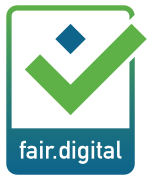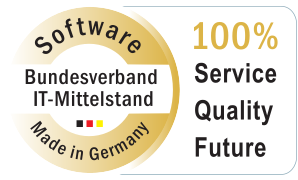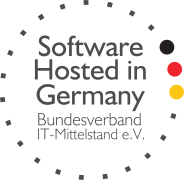A
Accelerometer
Acceleration sensors, so-called accelerometers, are built into smartphones. When the device is moved, the accelerometer measures the force displacement on the three axes X, Y and Z. The sensor data is used as an initial sensor. The sensor data is used as an initial sensor. In this way, energy can be saved.
API
API stands for “application programming interface”. A programming interface is a part of a program that is made available by a software system to other programs for connection to the system. For example, an API is used to integrate data from a facility management software into the back-end of contagt so that it can be used automatically in the guide.
Angle of Arrival (AoA)
Angle of Arrival (AoA) is a method that detects the angle of reception of signals, i.e. the direction from which signals are coming. AoA is also used for position determination inside buildings. In addition to the signal strength (see RSSI), the angle at which the signal is picked up is also taken into account here.
Asset Tracking
Asset tracking means the tracking of goods and objects. Not only can the current location of an asset be tracked in real time, but complete movement histories of the asset can also be shown. For this purpose, different technologies are used and combined with each other.
B
Barometer
The barometer is a sensor in smartphones that measures the air pressure. Thus, it can also provide information about the altitude at which the smartphone is located, e.g. the floor.
Beacon
A beacon is a small radio transmitter that sends out a Bluetooth signal (see Bluetooth) with its own identity. Smartphones can receive and interpret this signal, e.g., to receive location-based messages or to calculate a position via the signal strengths. So the logic is in the receiving devices – the beacons themselves cannot send notifications, collect user data or store it. Beacons operate on batteries for several years. It is also possible to connect them directly to the power grid. Apple’s beacon standard is called “iBeacon” (see iBeacon), Google’s “Eddystone” (see Eddystone).
Bluetooth
Bluetooth is an industry standard for wireless data transmission over short distances between devices, based on radio technology. For example, data can be exchanged between computers and/or smartphones, or devices such as wireless speakers or computer mice can be connected. In addition, Bluetooth Low Energy (Bluetooth LE, BLE) has been developed. BLE consumes significantly less energy. Thus, the battery life of BLE beacons (see Beacons) is several years without the need for an external power supply. Alternatively, beacons can also be connected to the power grid. The range varies, as walls and metal elements, for example, significantly reduce reception. Rarely do other electrical devices or radio networks have a negative effect. The Android operating system supports BLE from version 4.3 (mid-2013). Apple’s iOS operating system has supported BLE since iOS 5.
C
Camera
VLC signals can be received with the camera integrated in smartphones (see VLC). For applications with VR (see Virtual Reality), information can be projected into the current camera image.
D
Digital twin
Digital Twin is a representation of a real object in the digital world. The digital twins consist of data and algorithms and can be coupled with the real world via sensors. In this context, they are interactive 2D and 3D maps of buildings and locations.
E
Eddystone
The BLE Beacon from Google is called Eddystone. It was presented in 2015 as a counter design to Apple’s iBeacon. Eddystone is a software protocol that is applied to beacons. Since the system was released as an open source program, it can be used on various platforms. In addition to an ID, entire web addresses can also be sent, allowing users to be presented with information in their web browser without having to first install a mobile app that utilizes the beacon signals.
G
Galileo
Galileo is Europe’s navigation satellite. The first global satellite navigation and positioning system is under civilian control, accessible for international cooperation and operated commercially. While Galileo supports European independence from the two military-controlled systems GPS (USA) and GLONASS (Russia), it is based on the same basic technology as GPS. Thus, in combination with GPS, it provides significantly higher accuracy as well as increased reliability.
Geofencing
Geofencing consists of geographic and fence. Based on the user’s location determined outdoors by GPS and Galileo, content (location-based messaging) is automatically suggested to the user. As soon as a user enters the imaginary geofence created in the backend, the location-based content is pushed to the mobile app. Geofencing is a subarea of LBS (see LBS).
GPS
The U.S. Global Positioning System (GPS) requires a clear line of sight to several satellites, which can be limited in outdoor areas by trees, clouds or high buildings, for example. Inside buildings, GPS reception is hardly possible. Therefore, other technologies such as BLE beacons (see Beacons) are used for indoor positioning and indoor navigation.
Gyroscope
The gyroscope is a sensor that is installed in the smartphone. It determines whether the device is held vertically or horizontally.
I
iBeacon
Apple launched iBeacon in 2013 with the introduction of their mobile operating system iOS 7. It is designed to extend the location services of their iOS mobile operating system. Although it is a BLE-based technology like Eddystone, iBeacons cannot send a URL.
Indoor Navigation
Indoor navigation is the flexible guiding or directing and navigating of people inside buildings. This is usually done with the help of a smartphone. Analogous to systems that navigate on roads outside buildings, indoor navigation displays the route to a specific point or announces it via audio support. Here, it is important to determine the user’s current position (see Positioning).
Indoor Positioning System (IPS)
An Indoor Positioning System (IPS) refers to a system that enables the positioning of people or objects indoors. Sometimes “Indoor Locating System” or “Real Time Locating System” are also used. The location engine and the positioning algorithms are the heart of an IPS. This is where sensor data is converted into position data.
Infrastructure
In this context, beacon infrastructure means the beacon installation in a building or a defined area. This includes software, hardware and firmware.
IoT
IoT is the abbreviation for Internet of Things. IoT is one of the major technology trends in recent years. The British technology researcher and co-inventor of the RFID chip, Kevin Ashton, coined the term “IoT” in 1999 and understands it as the connection of physical things with a structure of virtual representations. Positioning is one of the most important and oldest application fields in the field of IoT. The platform approach means that all components of the location-based services are networked with each other.
L
Locating
Locating is the determination of the location of an object or person.
Location-based Services
Location-based services (LBS) are mobile services that provide users with content that is relevant to them at that moment and in that place, or provide services of another kind. Today, LBS can be found in many industries, especially in stationary retail, tourism and transportation, but also in the context of digitalization in Industry 4.0. Examples include indoor navigation and geofencing.
M
Magnetometer
The sensor built into the smartphone measures the strength of the earth’s magnetic field and its direction using three axes. Although it could theoretically be used to determine the position inside buildings, this is usually not done because it is often disturbed by magnetic sources such as power cables.
Major/ Minor
s. UUID
N
NFC
Near Field Communication (NFC) is a new wireless data transmission technology used in most new smartphones. NFC tags work passively without a power source over short distances of about 5 cm. With contagt, they transmit location data by simply touching the smartphone and ensure that the application is launched or downloaded on first contact. Attention: Currently this NFC functionality only works on Android smartphones and on iPhones from iOs 11. Alternatively or supplementary QR codes (see QR codes) can be used.
O
Opt-In
Opt-in is a procedure in which a user must actively agree to an option. Opt-in is used, for example, in the collection, storage and analysis of user data related to data protection or the sending of push messages.
P
POI
Point of interest, or PII for short, is a point or place of interest, e.g. restrooms, parking lots or canteens. On a digital map, POIs are represented as icons. Usually POIs have coordinates, a name and an icon. However, they can also have additional information such as opening hours, description or contact details.
Positioning
Positioning is the change of an object or person in location and spatial position. Positioning thus describes the possibility of determining the location or position of a terminal device, i.e. a person or an object (asset). Various technologies are used for this purpose.
PropTech
ropTech is also called property tech. PropTech encompasses modern technological developments in the field of building management. In addition to the digitalization of management, this also includes the use of LBS and sensors.
Proximity Marketing
Proximity marketing or Bluetooth marketing comprises the location- and time-based provision of content, e.g. offers, coupons. The prerequisite for this is that the app has been installed in advance and the user has opted in. Stores are a frequent use case.
Push notification
Push notification is also called push notification. These are messages that appear on the smartphone when the app (InApp) is closed and opened. In marketing measures (see Proximity marketing), consumers show a higher acceptance for InApp push messages.
Q
QR-Codes
Quick Response Codes (QR codes) are binary codes that are read by the smartphone camera and provide information for further processing. Thus, scanning a QR code can directly display certain internet pages or download apps. At contagt, they fulfill the same function as the NFC tags: On the one hand, the notification of the current location and, on the other hand, the download of the application upon first contact, or the automatic start of the app.
R
RFID
RFID stands for Radio-Frequency Identification. When using RFID, objects, people and animals are identified and located by electromagnetic waves. In addition, data can be read and stored without contact. An RFID system consists of a transponder, also called an RFID tag or radio label, and a reader. As a rule, the reader must be located within a radius of a few centimeters to one meter around the transponder for data to be exchanged. In contrast, active RFID tags have their own battery and have a much greater range. RFID technology is mainly used for asset tracking in production and logistics, for example, to track where an item is currently located in the entire production chain. RFID is one of the first applications of IoT (see IoT).
RTLS
RTLS stands for Realtime Location System, in German Echtzeit-Lokalisierungssysteme or real-time location systems. Due to signal attenuation indoors, RTLS are used and rely on radio location systems to determine the positions of people and objects indoors in real time. RTLS are used, for example, in healthcare, production and logistics, and security technology.
S
SDK
SDK stands for Software Development Kit and is a collection of program code (components). An SDK allows the integration of program code components into already existing programs. The functions developed by contagt can thus be integrated as SDK into third party systems such as already existing apps.
Signage
Signage is the conception and design of guidance and orientation systems. As a rule, this is done by specialized designers.
Smartphone sensor fusion
Many different sensors can be found in modern smartphones. Besides the familiar Bluetooth, GPS, NFC, camera and WLAN, there is also a barometer, gyroscope and accelerometer, for example. Additional information can be obtained in combination. Vertical sensor fusion of different sensors provides a more homogeneous and reliable result than individual sensors.
T
Tag
This can be a number of different things. First, there are NFC chips/tags (see NFC). In asset tracking, a beacon or other transmitter attached to an object is called a tag.
Trilateration and triangulation
Trilateration can be used to determine the absolute position of objects, such as beacons, by measuring the distance. With triangulation, the angle is also taken into account in the measurement. Within buildings, trilateration and triangulation are used for surveying, positioning and navigation.
Turn-by-Turn-Navigation
With turn-by-turn navigation, also called step-by-step navigation, users are guided step by step to their destination. They are alerted to the required changes in direction in good time. Automatic updating of the instructions is made possible by continuously updating the user’s position.
U
Ultrasound
Ultrasonic positioning uses audio signals at the speed of sound. The time from sending to receiving the respective signal is measured. The high-frequency acoustic signals cannot be perceived by humans.
UWB
UWB stands for Ultra-wide Band and is a technology that can be used to determine positions within rooms. In contrast to BLE and WLAN, it is possible to achieve accuracy in the sub-meter range. Thus, UWB is mainly used in industrial facilities. The disadvantage is the high infrastructure effort and associated costs.
UUID
UUID stands for Universally Unique Identifier and is a standard identifier used in software development. Within a network, the UUID can be used to identify all associated beacons. Major are used to identify and distinguish a group – for example, all beacons on a particular floor or room could be assigned a unique major. Minor are used to identify and distinguish a single beacon within a group of beacons that share the same major.
V
Virtual Reality (VR)
VR can be understood as a medium consisting of a computer-generated, interactive world. This completely surrounds the user, appeals to one or more senses with the help of suitable systems, so that the user has a particularly immersive experience. contagt offers 360° media (photos and videos) which, just like VR, create immersion, i.e. the feeling of being immersed in the content.
VLC
VLC stands for Visible Light Communication and was developed by Philips Lighting. Philips uses LED lights for local navigation and information transmission. The light signals from the LED luminaires transmit an individual coding for each luminaire that is perceptible to the smartphone camera but not to the human eye. This requires neither a WLAN nor a cellular connection. In combination with Bluetooth technology, this results in high positioning accuracy, which is needed especially in food retail applications. The disadvantage is that the smartphone must be held in a certain position, which is often unnatural for the user.
W
WLAN
WLAN stands for Wireless Local Area Network and refers to a local radio network for data transmission. In addition, WLAN can also be used for positioning by having the receiver (smartphone, tablet) measure the signal strength of a large number of hotspots positioned in the building. The position is then determined via trilateration and/or fingerprinting. Often, a WLAN infrastructure is already present in the building, which can be used accordingly. However, end devices from iOS version 4.3, i.e. all newer iPhones, do not support this positioning.
0 - 9
360° media
360° media can be photos or videos. Like VR applications, these 360° images create an immersive experience. This can be significantly enhanced by the use of head-mounted displays (colloquially VR glasses) and the user-centered view. In contrast to VR, however, there is no real-time calculation when playing 360° media and the interaction options are fewer.




